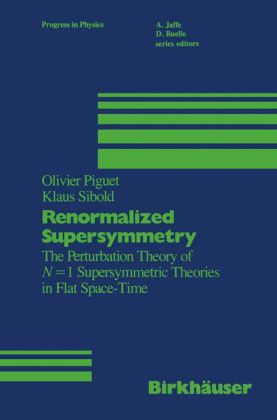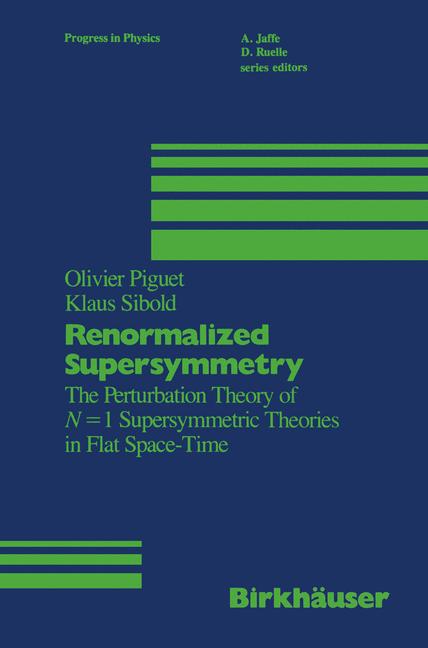Bücher versandkostenfrei*100 Tage RückgaberechtAbholung in der Wunschfiliale
Ihr Ostergeschenk: 15% Rabatt auf viele Sortimente11 mit dem Code OSTERN15
Jetzt einlösen
mehr erfahren
Zustellung: Mi, 30.04. - Mo, 05.05.
Versand in 3 Wochen
VersandkostenfreiBestellen & in Filiale abholen:
The present book grew out of lecture notes prepared for a "Cours du troisieme cycle de la Suisse Romande", 1983 in Lausanne. The original notes are considerably extended and brought up to date. In fact the book offers at many instances completely new derivations. Half-way between textbook and research monograph we believe it to be useful for students in elementary particle physics as well as for research workers in the realm of supersymmetry. In writing the book we looked back not only on ten years of super symmetry but also on ten years of our own life and work. We realize how deeply we are indebted to many friends and colleagues. Some shared our efforts, some helped and encouraged us, some provided the facili ties to work. Their list comprises at least C. Becchi, S. Bedding, P. Breitenlohner, T. E. Clark, S. Ferrara, R. Gatto, M. Jacob, W. Lang, J. H. Lowenstein, D. Maison, H. Nicolai, J. Prentki, A. Rouet, H. Ruegg, M. Schweda, R. Stora, J. Wess, W. Zimmermann, B. Zumino. During the last ten years we had the privilege to work at CERN (Geneva), Departement de Physique Theorique (University of Geneva), Institut fUr Theoretische Physik (University of Karlsruhe) and at the Max-Planck-Institut fUr Physik und Astrophysik (Munich) for which we are most grateful. Grate fully acknowledged is also the support we received by "the Swiss National Science Foundation" (O. P. ), the "Deutsche Forschungsgemeinschaft" (Heisenberg-Fellowship; K. S. ).
Inhaltsverzeichnis
I The Supersymmetry Algebra and its Representation of Fields. - Sect. 1 The supersymmetry algebra, superspace, superfields. - Sect. 2 The superconformai algebra. - II Specific Models in the Tree Approximation. - Sect. 3 Chiral models. - 3. 1 The free chiral field. - 3. 2 Interacting chiral fields. - 3. 3 The O'Raifeartaigh model. - Sect. 4 Abelian gauge models. - 4. 1 Free abelian gauge fields. - 4. 2 SQED. - 4. 3 S'QED and S'QED. - Sect. 5 Non-abelian gauge models. - 5. 1 Non-abelian gauge transformations. - 5. 2 BRS-invariance. - 5. 3 General solution of the Slavnov identity. - 5. 4 Interpretation of the parameters ak. - 5. 5 Gauge independence. - 5. 6 Summary of section 5. - Sect. 6 Supercurrents. - 6. 1 Generalities. - 6. 2 Chiral models. - 6. 2. 1 Massless Wess-Zumino model. - 6. 2. 2 Massive Wess-Zumino model. - 6. 2. 3 General chiral model. - 6. 3 Abelian gauge theory. - 6. 4 Non-abelian gauge theory. - 6. 5 Identification of component currents. - 6. 6 Superfield form of internal symmetry currents. - III Perturbation Theory in Superspace. - Sect. 7 A simple example. - Sect. 8 Feynman rules and power counting. - Sect. 9 The subtraction scheme. - Sect. 10 Normal products. - Sect. 11 The action principle. - Sect. 12 Symmetric operators. - IV Renormalization: Hard Anomalies. - Sect. 13 Rigid symmetries. - 13. 1 Consistency conditions, the algebraic technique. - 13. 2 Symmetry breaking. - 13. 3 Supersymmetry. - 13. 3. 1 Wess-Zumino model. - 13. 3. 2 O'Raifeartaigh model. - 13. 3. 3 SQED. - 13. 3. 4 S'QED. - 13. 3. 5 SYM. - 13. 4 Rigid gauge invariance. - 13. 5 R-invariance. - 13. 5. 1 Wess-Zumino model. - 13. 5. 2 O'Raifeartaigh model. - 13. 5. 3 SQED. - 13. 5. 4 S'QED. - 13. 5. 5 SYM. - Sect. 14 Abelian gauge invariance. - 14. 1 SQED. - 14. 2 S'QED. - Sect. 15 Non-Abelian gauge invariance. - 15. 1 Statement of the problem. - 15. 2 The consistency condition. - 15. 3 Solution of the consistency condition: the anomaly. - 15. 4 The anomaly in the Slavnov-identity. - Sect. 16 Renormalized Supercurrents. - 16. 1 The Wess-Zumino model. - 16. 1. 1 The massless case. - 16. 1. 2 The massive case. - 16. 1. 3 Summary. - 16. 2 Supersymmetric QED. - 16. 2. 1 Massless vector field. - 16. 2. 2 Massive vector field. - 16. 2. 3 Massive vector field, massless matter fields. - 16. 2. 4 The gauge invariance of the supercurrent. - 16. 2. 5 The non-renormalization of the axial anomaly. - 16. 3 Supersymmetric Yang-Mills theory. - 16. 3. 1 General preparation. - 16. 3. 2 The BRS-invariance of current and breaking. - 16. 3. 3 Renormalized supercurrent and Callan-Symanzik equation. - 16. 3. 4 The "conserved" supercurrent. - V Renormalization: Soft Anomalies. - Sect. 17 Mass generation-the O'Raifeartaigh model. - Sect. 18 The off-shell infrared problem in SYM. - 18. 1 Statement of the problem. Tree approximation. - 18. 2 Higher orders: Solution of the cohomology. - 18. 3 Higher orders: The absence of infrared anomalies and the Callan-Symanzik equation. - 18. 4 Discussion of the result. Open questions. - Appendix A Notations, conventions and useful formulae. - Appendix B Generating functionals. - Appendix D Symmetric insertions and differential operators. - Appendix E Solution of some superfield constraints. - References.
Mehr aus dieser Reihe
Produktdetails
Sprache
englisch
Seitenanzahl
348
Reihe
Progress in Mathematical Physics, 12
Autor/Autorin
Oliver Piguet, Klaus Sibold
Verlag/Hersteller
Produktart
gebunden
Gewicht
625 g
Größe (L/B/H)
237/154/21 mm
ISBN
9780817633462
Entdecken Sie mehr
Bewertungen
0 Bewertungen
Es wurden noch keine Bewertungen abgegeben. Schreiben Sie die erste Bewertung zu "Renormalized Supersymmetry" und helfen Sie damit anderen bei der Kaufentscheidung.



































